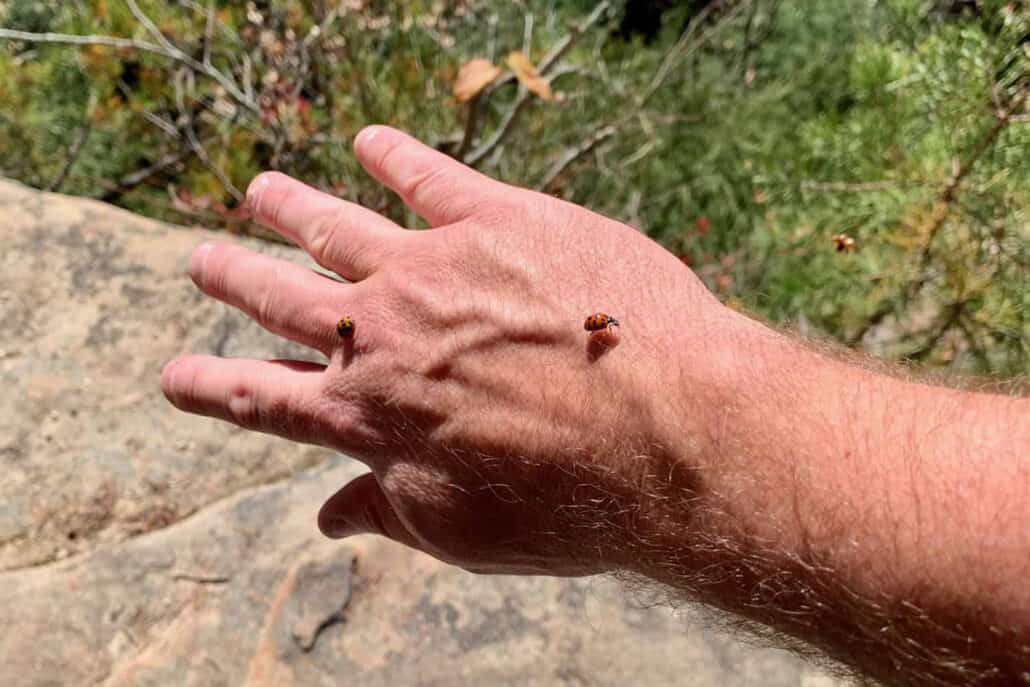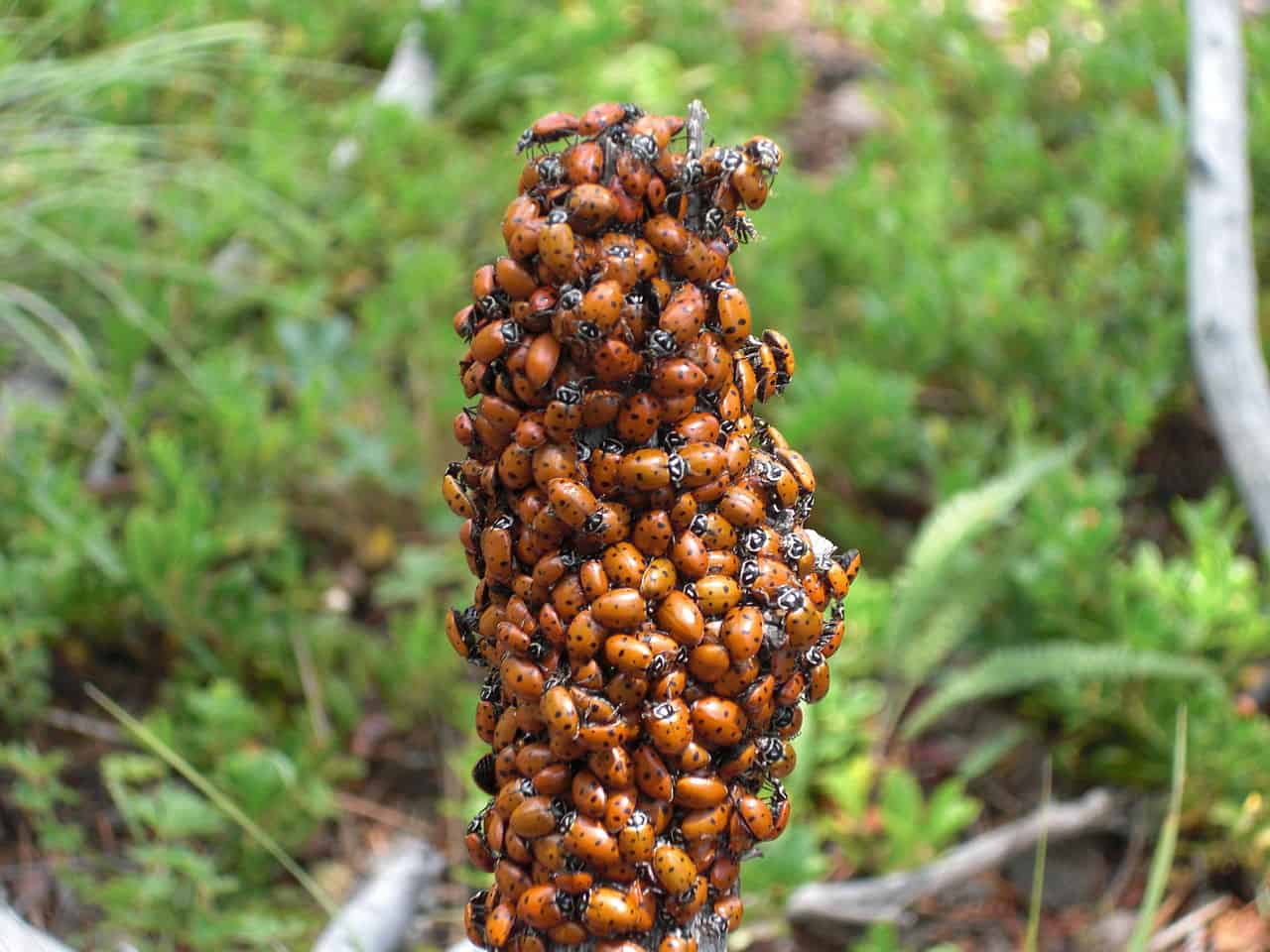
Last weekend, my guy and I took a drive down to southeastern Ohio to hike the trails in one of my favorite spots, Conkles Hollow State Nature Preserve. Cloudless blue skies, near-peak fall foliage, 60-degree temps… we couldn’t have asked for a more perfect November day. I brought my binoculars, of course, in hopes of spotting, well, anything, since fall migration has quieted down a good bit.
After our 100-foot ascension to the top of the gorge, I was excited to hear some chipping as we trekked through the woods. We stopped to listen and try to get sights on the source, but the bird remained hidden, the trees still hanging onto most of their leaves. I suspected we had a kinglet at hand—those tiny, flitty, adorable birbs that become more prevalent around here this time of year.
I pulled out the Merlin app to play the chipping call of a golden-crowned kinglet, my guess at our mystery bird, and sure enough—the chipping on my phone was echoed by chipping in the trees—and moving in closer. (Be sure to follow proper playback etiquette when doing this!) Soon we had not one but two kinglets perched a few feet away, curiously peering down at us, offering good long looks at that eponymous golden streak on the crest. I felt triumphant in both my correct identification and in successfully summoning this striking species into full view—glimpses of this frenetic insect forager are rarely that satisfying!

While this was the most memorable avian encounter of the day, the kinglets’ thunder was stolen by a more conspicuous and plentiful winged creature—the ladybug. Or lady beetle, or ladybird beetle (as they call them outside the US), if you will.
A ladybug more conspicuous than a bird? Well, when there are hundreds of them whizzing around, yes!
When we had arrived at the preserve, we had noticed a number of the little round, reddish insects zipping by, landing on us and the car. They were less prevalent as we moved into the woods, but once we summited the trail to the rim of the gorge and stood in the open sunshine, they were literally everywhere we looked.
Gazing out over the treetops below, we could see dozens flying every which way across the expanse before us. It was kind of mesmerizing to see so many moving about. If that old adage about ladybugs being good luck is true, then we were going to go play the lottery!
I don’t know much about ladybugs, but I did know that there is a native species in Ohio, and a non-native invasive species, which is the one that is commonly found inside homes in the winter. I had an inkling that these were the latter, but I would have to wait until we were back in cell service to fire up the Google machine to confirm my suspicions.
Later, as we drove away from the preserve, ladybugs were bouncing off the windshield—and several stowaways revealed themselves inside the car. And back in Columbus, we continue to find them. This week I had several on my balcony rail basking in the sun, one on my doorknob, another inside on my lampshade… They’re here, they’re there, they’re… everywhere! <I’m in a serious Ted Lasso place right now—IYKYN!>

A quick look around the internet confirmed that we were indeed seeing the non-native species, which is called the multicolored Asian lady beetle (MALB). (Ladybugs are not actually classified as bugs; they are beetles, which apparently are not bugs… who knew!)
The “multicolored” refers to the many shades of yellowish to orangish to reddish they can take on. And “Asian” obviously is because that is where they hail from—specifically Russia, Japan, Korea, and other parts of eastern Asia.
MALBs typically have 19 black spots… but that can vary wildly, and they can even have no spots! The best identifier of this species is the black marking behind their head, which appears as an “M” on the white pronotum, which is the top covering of the middle body part.
The most common native ladybug species in North America is the convergent lady beetle, which typically has 13 spots, less color variation, and two distinct white markings on the pronotum angled toward each other (convergent).
Like all ladybugs, MALBs are predators of soft-bodied insects, particularly aphids, which is why they were imported by the US Department of Agriculture in the early 1900s—to help control insect pests that harm fruit orchards and other agricultural commodities. By the end of the 20th century, the species was firmly established in North America, and is actually now considered an invasive species on a global scale.
While they are not harmful to humans (they are very rare biters and cannot break skin and do not spread diseases), and they do good work in controlling pest insects, reducing the need for insecticides, they are problematic for a few reasons—mainly that they congregate in large numbers in people’s homes, becoming a pest insect themselves, and they are competing with native ladybug species, causing them to decline in numbers.

One thing I had wondered aloud while standing on the rim of the gorge watching the flurry of ladybug activity before us was, “Don’t the birds eat them? The birds should be out here having a feast!” But I had forgotten something I had learned when I started getting into caterpillars last summer: red is a color that tells potential predators, “I do NOT taste good!”
When threatened, ladybugs will secrete from their leg joints a foul-smelling body fluid, which is their “blood.” And MALBs are known to have one of the more potent secretions of all the ladybug species.
Besides smelling bad, the fluid from a smashed ladybug can permanently stain walls, curtains, and carpets. So if you do find them in your home, you will want to remove them carefully. Insecticides are not recommended; rather it is best to remove single ladybugs by relocating them outdoors.
For larger numbers in your home, use a “fan-bypass” vacuum (e.g., Shop-Vac), or you could risk turning your vacuum into an unusable “beetle blender.” Um, no thank you!
To keep MALBs out of your home, first understand that they are not intentionally invading your house to stay warm for the winter, a common misbelief. They have accidentally made their way inside by slipping through cracks around doors, windows, screens, and other openings.
An eighth of an inch is all the gap they need to find their way in. So the best prevention is to take measures to keep them from entering the home in the first place. The Ohio State University Extension offers several tips for how to do this in its excellent Multicolored Asian Ladybug Fact Sheet—and helpfully points out that these methods will also keep out other unwanted pests (like stinkbugs, ick!).
Because ladybugs are cold-blooded, they are able to survive cold winters by matching their body temperature to the outdoor temperature. A winter inside a heated home ultimately means certain death for the beetles, which is why it is common to find large numbers of dead ladybugs indoors.
They prefer to overwinter by congregating under siding or shingles or leaf litter. Sheltered locations keep their body temperature cool, which keeps their metabolism low, which conserves their body fat so they don’t starve to death before their food sources return in the spring.
Once again, a day spent immersed in nature delivered ten-fold not only in its beauty but in all the wonders offered, the curiosity piqued, the questions raised, the knowledge gained. Sometimes it’s the birds that take center stage, sometimes it’s the bugs… er, beetles.




